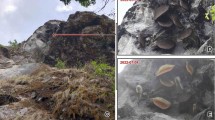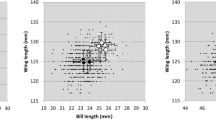Abstract
Flight is the main form of dispersion for adult triatomines. It is postulated here that some body morphological parameters vary in T. guasayana according to a greater or lesser wing development, which would allow to estimate their flight capacity. Furthermore, there are observations which allow to suggest that the wings alone would not present the entirety of the information on the flight ability of an insects. It is postulated here that some body morphological parameters vary in T.guasayana according to a greater or lesser wing development. The study aims to verify the hypothesis that the variation of the wing phenotype in triatomines is accompanied by variations of other body structures, particularly the head. Geometric morphometry of heads, thorax width and wing length of T.guasayana brachypterous and macropterous was used. The results allow to confirm that there is a relationship between the wing condition of T. guasayana and other variables – unrelated to wings – that can be associated with flight capacity. The shape of the head changes with the wing condition. The results obtained suggest that the diversity of wing morphotypes imply a diversity in head conformation, suitable for flight: macropterous have a greater distance between eyes and shorter heads, while brachy or micropterous exhibit smaller eyes and larger heads. For the first time, brachypterous individuals of T.guasayana are recorded here, posing the existence of a pronounced alary polymorphism in this species. Identifying these markers in triatomines is of special importance to understand the processes of domicile recolonization after vector control campaigns.






Similar content being viewed by others
References
Abrahan LB, Gorla DE, Catalá SS (2011) Dispersal of Triatoma infestans and other Triatominae species in the arid Chaco of Argentina: flying, walking or passive carriage? The importance of walking females. Mem Inst Oswaldo Cruz 106:232–239
Almeida CE, Oliveira HL, Correia N, Dornak LL, Gumiel M, Neiva VL, Harry M, Mendonça VJ, Costa J, Galvão C (2012) Dispersion capacity of Triatoma sherlocki, Triatoma juazeirensis and laboratory-bred hybrids. Acta Trop 122:71–79
Bernard MF, McCauley SJ (2008) Integrating across life-history stages: consequences of natal habitat effects on dispersal. Am Nat 17:553–567
Blanke A (2018) Analysis of modularity and integration suggest evolution of dragonfly wing venation mainly in respose to functional demands. J R Soc Interface. https://doi.org/10.1098/rsif.2018.0277
Bookstein F (1991) Thin-plate splines and the atlas problem for biomedicalimages. In: Colchester ACF, Hawkes DJ (eds) Information processing in medical imaging. Springer-Verlag, Wye, pp 326–342
Cavallo MJ, Amelotti I, Gorla DE (2016) Invasion of rural houses by wild Triatominae in the arid Chaco. J Vector Ecol 41:97–102
Caillaud MC, Boutin M, Braendle C, Simon JC (2002) A sex-linked locus controls wing polymorphism in males of the pea aphid, Acyrthosiphon pisum (Harris). Heredity. 89:346–352
Carbajal de la Fuente AL, Minoli SA, Lopes MC, Noireau F, Lazzari CR, Lorenzo MG (2007) Flight dispersal of the Chagas disease vectors Triatoma brasiliensis and Triatoma pseudomaculata in northeastern Brazil. Acta Trop 101:115–119
Carcavallo RU (1985) Técnicas de estudio de triatominos en ambiente silvestre. En: Carcavallo, R.U., Rabinovich, J.E., Tonn, R.J., editores. Factores biológicos y ecológicos en la enfermedad de Chagas. Epidemiología, vectores. Washington, D.C.: OPS/OMS; 1985. p. 49-52
Carcavallo RU, Canale DM, Martínez A (1988) Hábitats de triatominos argentinos y zonas ecológicas donde prevalecen. Chagas 5:8–17
CLIC49 (2019) J.P., Dujardin. http:/xyom-clic.eu
Denno RF (1994) Life history variation in planthoppers. In: Denno RF, Perfect TJ (eds) Planthoppers: their ecology and management. Chapman & Hall, New York, pp 163–215
Denno RF, Roderick GK, Olmstead KL, Dobel HG (1991) Density-related migration in planthoppers (Homoptera: Delphacidae): the role of hábitat persistence. Am Nat 138:1513–1541
Di Iorio O, Gürtler RE (2017) Seasonality and temperature-dependent flight dispersal of Triatoma infestans(Hemiptera: Reduviidae) and other vectors of Chagas disease in Western Argentina. J Med Entomol 54:1285–1292
Dixon AFG (1985) Aphid ecology. Blackie, London
Dixon AFG, Howard MT (1986) Dispersal in aphids, a problem in resource allocation. In: Danthanarayana W (ed) Insect flight: dispersal and migration. Springer-Verlag, Berlin, pp 145–151
Dujardin JP (2008) Morphometrics applied to medical entomology. Infection Gen Evol 8:875–890
Dujardin JP, Slice D (2007) Geometric morphometrics. Contributions to medical entomology. In: Tibayrenc, M. (Ed.), encyclopedia of infectious diseases. Modern methodologies. Wiley & Sons, Chapter 25, pp. 435–447
Dujardin JP, Bermudez H, Casini C, Schofield CJ, Tibayrenc M (1997) Metric Differences Between Silvatic and Domestic Triatoma infestans (Heteroptera: Reduviidae) in Bolivia. J Med Entomol 34:544–551
Gajate PP, Bottazzi MV, Pietrokovsky SM, Wisnivesky-Colli C (1996) Potential colonization of the Peridomicile by Triatoma guasayana (Hemiptera: Reduviidae) in Santiago del Estero, Argentina. J Med Entomol 33:635–639
Gu H, Hughes J, Dorn S (2006) Trade-off between mobility and fitness in Cydia pomonella L. (Lepidoptera: Tortricidae). Ecol Entomol 31:68–74
Gurevitz JM, Kitron U, Gürtler RE (2007) Flight muscle dimorphism and heterogeneity in flight initiation of field-collected Triatoma infestans (Hemiptera: Reduviidae). J Med Entomol 44:186–191
Hardie J, Lees AD (1985) Endocrine control of polymorphism and polyphenism. In: Kerkut GA, Gilbert LI (eds) Comprehensive insect physiology, biochemistry and pharmacology. Pergamon, New York, pp 441–490
Hernández ML, Abrahan L, Dujardin JP, Gorla DE, Catalá S (2011) Phenotypic variability and population structure of peridomestic Triatoma infestans in rural areas of arid Chaco (western Argentina): spatial influence of macro and microhabitats. Vector Borne Zoonotic Dis 11:503–513
Hernández ML, Dujardin JP, Gorla DE, Catalá SS (2013) Potential sources of Triatoma infestans reinfesting peridomicilies identified by morphological characterization in los llanos, La Rioja, Argentina. Mem Inst Oswaldo Cruz 107:91–97
Hernández ML, Dujardin JP, Gorla DE, Catalá SS (2015) Can body traits, other than wings, witness the flight ability of Triatominae bugs, vectors of Chagas disease ? Rev Soc Bras Med Trop 48:682–691
Hernández ML, Amelotti I, Catalá SS, Gorla DE (2018) Does nutrition influence sexual dimorphism in Triatoma infestans (Hemiptera: Reduviidae) of natural habitats? Rev Soc Entomol Arg 77:1–8
Ishikawa A, Miura T (2007) Morphological differences between wing morphs of two Macrosiphini aphid species, Acyrthosiphon pisum and Megoura crassicauda (Hemiptera, Aphididae). Sociobiology 50:881–893
Jackson DJ (1928) The inheritance of long and short wings in the weevil, Sitona hispidula, with a discussion of wing reduction among beetles. Trans R Soc Edinburgh 55:665–735
Jaramillo N, Castillo D, Wolff EM (2002) Geometric morphometric differences between Panstrongylus geniculatus from field and laboratory. Mem Inst Oswaldo Cruz 97:667–673
Johansson LC, Engel S, Baird E, Dacke M, Muijres FT, Hedenström A (2012) Elytra boost lift, but reduce aerodynamic efficiency in flying beetles. J R Soc Interface 9:2745–2748
Kalmus H (1945) Correlations between flight and Visios, and particularly between wings and Ocelli, in insects. Proc R Entomol Soc London 20:84–96
Kring JB (1977) Structure of the eyes of the pea aphid, Acyrthosiphon pisum. Ann Entomol Soc Am 70:855–860
Le Roy C, Debat V, Llaurens V (2019) Adaptative evolution of butterfly wing shape: from morphology to behaviour. Biol Rev 94:1261–1281
Lees AD (1961) Clonal polymorphism in aphids. In: Kennedy JS (ed) Insect Polymorphism. R. Entomol. Soc, London, pp 68–79
Lehane MJ, Schofield CJ (1982) Flight initiation in Triatoma infestans (Klug) (Hemiptera, Reduviidae). Bull Entomol Res 72:497–510
Lehane, M.J., McEwen, P.K., Whitaker, C.J, Schofield, C.J., 1992. The role of temperature and nutritional status in flight initiation by Triatoma infestans. Acta Trop 52: 27–38
Lin X, Xu Y, Jiang J, Lavine M, Lavine MC (2018) Host quality induces phenotypic plasticity in a wing polyphenic insect. PNAS 115:7563–7568. https://doi.org/10.1073/pnas.1721473115
Lorenz MW (2007) Oogenesis-flight syndrome in crickets: age-dependent egg production, flight performance, and biochemical composition of the flight muscles in adult female Gryllus bimaculatus. J Insect Physiol 53:819–832
McEwen PK, Lehane MJ (1993) Factors influencing flight initiation in the triatomine bug Triatoma sordid (Hemiptera: Reduviidae). Insect Sci Appl 14:461–464
Miyazaki M (1987) Forms and morphs of aphids. In: Minks AK, Harrewijn P (eds) Aphids, their biology, natural enemies and control. Elsevier, Amsterdam, pp 163–195
Moser JC, Reeve JD, Bento JM, Lucia TM, Cameron RS et al (2004) Eye size and behaviour of day- and night-flying leafcutting ant alates. J Zool 264:69–75
Nattero J, Malerba R, Rodríguez CS, Crocco L (2013) Phenotypic plasticity in response to food source in Triatoma infestans (Klug, 1834) (Hemiptera, Reduviidae: Triatominae). Infect Genet Evol 19:38–44
Noireau F, Flores R, Vargas F (1999) Trapping sylvatic triatominae (Reduviidae) in hollow trees. Trans R Soc Trop Med Hyg. Oxford University Press (OUP) 93:13–14
Ospina-Garcés SM, Escobar F, Baena ML, Davis ALV, Scholtz CH (2018) Do dung beetles show interrelated evolutionary trends in wing morphology, flight biomechanics and habitats preference?. Evolutionary Ecology 32:663–682
Riley J, Reynolds D, Farrow R (1987) The migration of Nilaparvata lugens (Stål) (Delphacidae) and other Hemiptera associated with rice during the dry season in the Philippines: a study using radar, visual observations, aerial netting and ground trapping. Bull Entomol Res 77:145–169
Roff DA (1984) The cost of being able to fly: a study of wing polymorphism in two species of crickets. Oecologia 63:30–37
Roff DA (1990) The evolution of flightlessness in insects. Ecol Monogr 60:389–421
Rohlf FJ (1999) Shape statistics: Procrustes superimpositions and tangent spaces. J Classif 16:197–223
Ross A (2017) Insect evolution: the origin of wings. Curr Biol 27:113–115
Sack C, Stern DL (2007) Sex and death in the male pea aphid: Acyrthosiphon pisum: the life-history effects of a wing dimorphism. J Insect Physiol 7:45
Schofield CJ, Lehane MJ, McEwen P, Catalá SS, Gorla DE (1992) Dispersive flight by Triatoma infestans under natural climatic conditions in Argentina. Med Vet Entomol 6:51–56
Statistica 10. Stat Soft Inc. 2011. Version 10. www.statsoft.com
Suarez-Tovar CM, Sarmiento CE (2016) Beyond the wing planform: morphological differentiation between migratory and nonmigratory dragonfly species. J Evol Biol 29:690–703
Taylor CP (1981a) Contribution of compound eyes and Ocelli to steering of locusts in flight: I. Behavioural Analysis. J Exp Biol 93:1–18
Taylor (1981b) Contribution of compound eyes and Ocelli to steering of locusts in flight ii. Timing changes in flight motor units 7. Exp Biol 93:19–31
Taylor GK, Krapp HG (2007) Sensory systems and flight stability: what do insects measure and why? Adv Insect Physiol 34:231–316
Tocco C, Dacke M, Byrne M (2019) Eye and wing structure closely reflects the visual ecology of dung beetles. J Comp Physiol A 205:211–221. https://doi.org/10.1007/s00359-019-01324-6
Tsuji H, Kawada K (1987) Development and degeneration of wing buds and indirect flight muscles in the pea aphid (Acyrthosiphon pisum (Harris)). Jap J Appl Ent Zool 31:247–252
Vega-Sánchez Y, Isarrarás-Hernández L, Castillo-Ayala P, Mendoza-Cuenca L (2011) Morfología alar y territorialidad en Hetaerina vulnerata. Biológicas 13:29–35
Vezzani D, Schweigmann NJ, Pietrokovsky SM, Wisnivesky-Colli C (2001) Characterization of Triatoma guasayana biotopes in a hardwood forest of Santiago del Estero, Argentina. Mem Inst Oswaldo Cruz 96:459–466
Williams NG, Schofield CJ (1985) The role of temperature in flight initiation of triatomine bugs. Trans R Soc Trop Med Hyg 79:282
Wisnivesky Colli C, Gürtler RE, Solarz ND, Schweigmann NJ, Pietrokovsky SM, Alberti A, Flo J (1993) Dispersive flight and house invasion by Triatoma guasayana and Triatoma sordida in Argentina. Mem Inst Oswaldo Cruz 88:27–32
Wratten SD (1977) Reproductive strategy of winged and wingless morphs of the aphids Sitobion avenae and Metopolophium dirhodum. Ann Appl Biol 35:319–331. https://doi.org/10.1111/j.1744-7348.1977.tb01918.x
Zelditch ML, Swiderski DL, Sheets HD, Fink WL (2004) Geometric morphometrics for biologist: a primer. Elsevier Academic Press, San Diego
Zera AJ (1984) Differences in survivorship, development rate and fertility between the longwinged and wingless morphs of the waterstrider, Limnoporus canaliculatus. Evolution 38:1023–1032
Acknowledgements
We thank L. Abrahan and I. Amelotti for their collaborations in the field collections.
Author information
Authors and Affiliations
Corresponding author
Ethics declarations
This work was funded by Consejo Nacional de Investigaciones Científicas y Técnicas (CONICET, Argentina). MLH and DEG are members of CONICET (Argentina).The authors declare that they have not conflict of interest. The work does not include research with humans. There are no trials that include experimentation on animals.
Additional information
Publisher’s note
Springer Nature remains neutral with regard to jurisdictional claims in published maps and institutional affiliations.
Rights and permissions
About this article
Cite this article
Hernández, M.L., Espinoza, J., Gomez, M. et al. Morphological changes associated with brachypterous Triatoma guasayana (Hemiptera, Reduviidae) and their relationship with flight. Int J Trop Insect Sci 40, 413–421 (2020). https://doi.org/10.1007/s42690-019-00092-9
Received:
Accepted:
Published:
Issue Date:
DOI: https://doi.org/10.1007/s42690-019-00092-9




